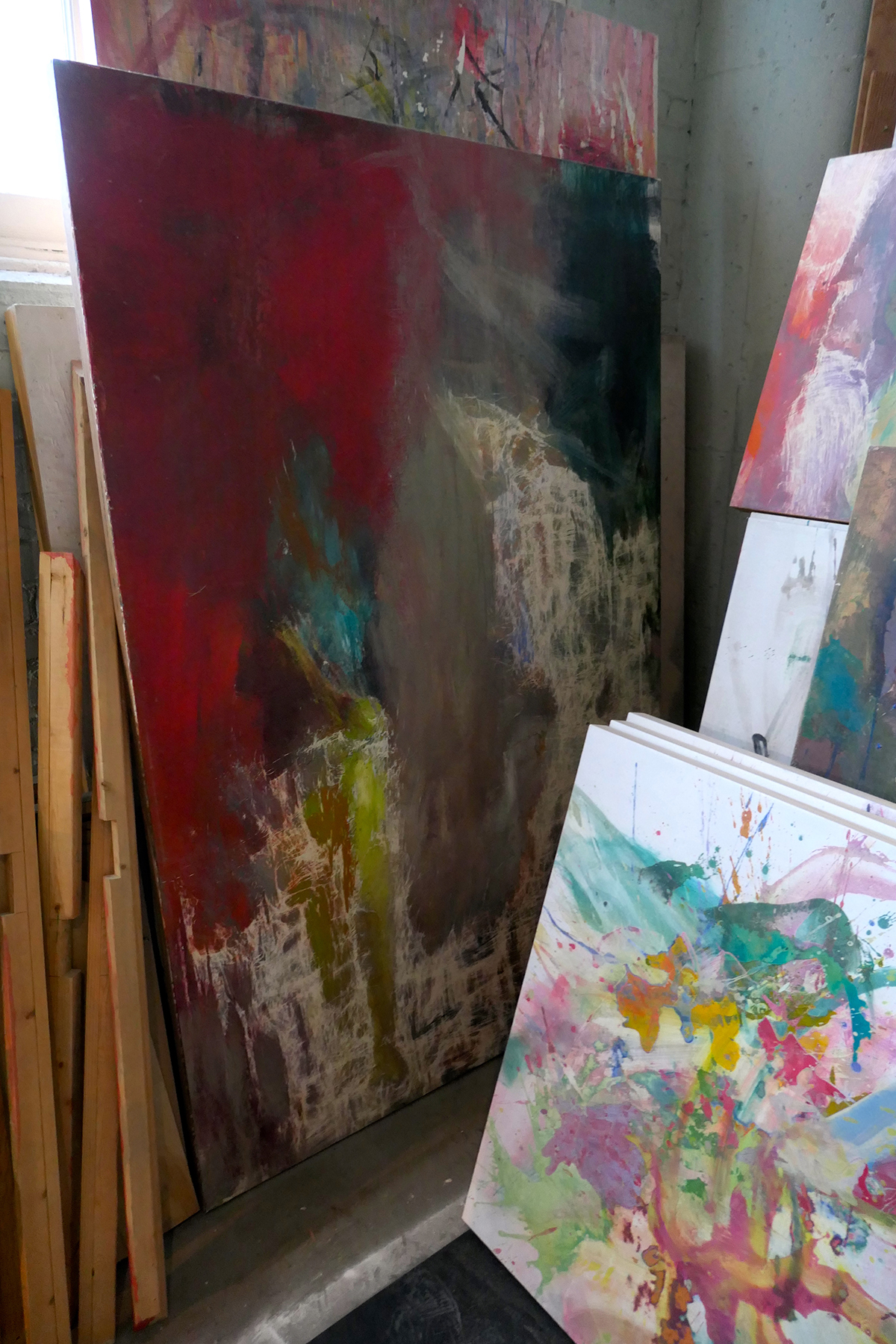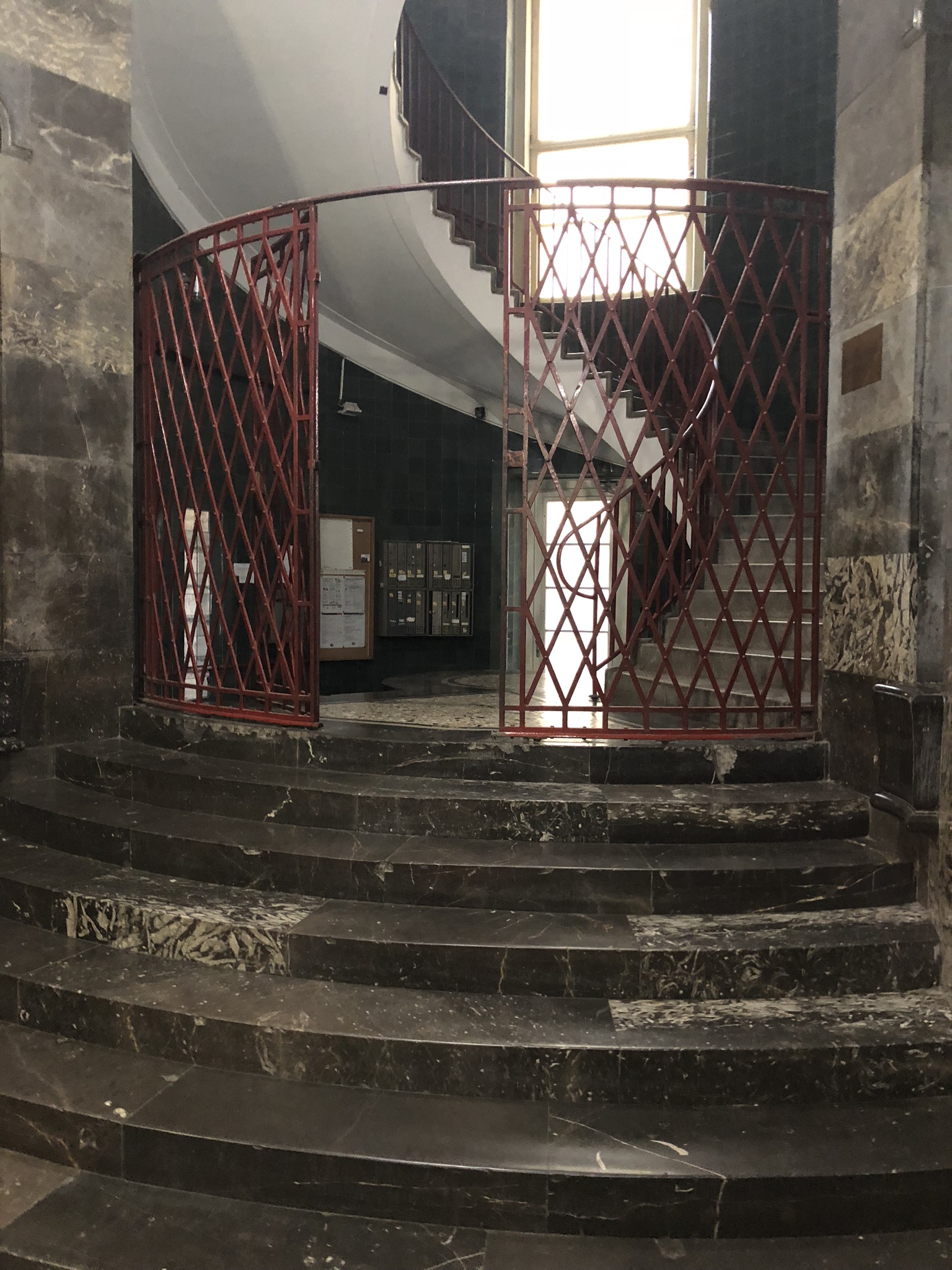Was glänzt, ist für den Augenblick geboren,
Das Echte bleibt der Nachwelt unverloren.
That which glitters is born for the moment;
The genuine remains intact for future days.
Johann Wolfgang von Goethe, Faust eine Tragödie, Kapitel 2: Vorspiel auf dem Theater (1808)
I was so cold when I left Dorothy Goode‘s studio after a visit last week that I could barely get the key into the car ignition. During our first ever encounter we had huddled, both in down jackets and hats, in front of a little electric stove in her unheated ware-house abode. The space had beautiful views, brilliant light and a damp iciness that crept into my arthritic bones. I could not help but think of Frans Hals, that radical observer of humanity, who was so impoverished at the end of his life that in the Dutch winter of 1664 he accepted three loads of peat on public charity, otherwise he would have frozen to death. (Of course he then had to portray the administrators of said charity, the Governesses of an Alms House in 17th century Haarlem – those faces all-telling.)

Not that Goode would accept alms. Ever. Fiercely independent, proud, accomplished and not at all risk-averse, she’ll probably persuade you rheumatism is the price you pay for pursuing your art. Or so I wager. After all, I have to run on the impressions of 2 hours of conversation with an artist intensely protective of her inner life.
Wager I shall. Our conversation led my thoughts back to the cautioning words of one of Hals’ landsmen, Vincent van Gogh. In a letter to his brother Theo, he was acutely aware of the temptation to exchange security for creative independence, mediocrity for daring. “How does one become mediocre? By going along with this today and conforming to that tomorrow, as the world wants, and by not speaking out against the world and by only following public opinion!” He compared himself and his brother “so the one, “a certain position or affluence and a businessman,” the other “poverty and exclusion, painter.”… “I feel that the future will probably make me uglier and rougher, and I see “a certain poverty” as my lot — but — but — I will be a painter … in short a being with feeling.” (Letter by Vincent van Gogh to his brother Theo on or about Sunday, 16 December 1883)

Plus ça change plus c’est la meme chose – if you follow your own path, defy convention, are immune to Zeitgeist and pursue what you – and not the world- want, and if there’s no trust fund carefully hidden in the wings, you do lack security to a degree that can veer into the frightening.
Forget talent. Forget vision. Forget skilled craft. I think John Berger put it best in Ways of Seeing (1972): “Capitalism survives by forcing the majority, whom it exploits, to define their interests as narrowly as possible.This was once achieved by extensive deprivation. Today in the developed countries it is being achieved by imposing a false standard of what is and is not desirable.”

*
The pressure to conform to “desirable standard” – dripping paint today, identity politics tomorrow, or was that yesterday? – is intense. Opting for shimmering instead of genuine is only increased by structural factors beyond your personal recognition as an artist. The number of failing galleries, often due to higher real-estate cost, means fewer options for representation, and the surviving ones will understandably select with an eye on their own bottom-line. This includes factoring in the taste of potential patrons and the artists’ ability to draw collectors in with personal connections and the like. Add to that the fact that new generations of buyers, who should replace the older ones now downsizing to their retirement homes, are exceptionally burdened with educational debt, have little homeownership that opens up space for collections and, importantly, tend to spend on experience rather than objects. The perfect storm, if you were not one of the rare break-out artists during the last few decades.
*

Conforming she ain’t. Mediocrity is the last term that would come to mind when perusing the body of art in her studio or assessing the richness of the conversation. True to a vision, the first.
I had seen and liked Goode’s work across the last decade at Butter’s when the gallery was still a brick & mortar enterprise. A recent show, Transfixed, at Augen, rekindled my interest and led to my request for an interview. What drew me in was what I perceived to be exuberance in these paintings, and the sense of something moving. In fact they recalled one of Piet Mondrian’s claims (I seem to be stuck on the Dutch today!) he made about his work in response to the suggestion by Calder that some of their parts should be made to move: “Well, I think my paintings are fast enough already.”

The perceived speed of Goode’s recent paintings seemed to me in equal part giddy and compulsively driven, a perfect tension between lifting your soul up and weighing your heart down with the emotional valence behind those expressions. One part that helps evoke a sense of lightness is the medium: egg tempera painting (mixing egg yolks with paint pigments and a liquid agent) feels inherently less heavy and foreboding compared to oils, tempera don’t darken over time and they often resemble pastels, in their thin layers and matte finish. Brushstrokes have to be fast and precise with the quick-drying tempera, and crosshatching carefully thought through. It is not a forgiving medium compared to oil, requiring years of practice for the skill levels seen in the exhibits at Augen.

The part that alludes to heaviness lies in the medium as well: heavy wood panels are the base substrate, covered with an absorbent ground, often Italian gesso, that requires tons of physical labor in cooking it up and applying it to the board. Overall, of course, it is the expansiveness of the gesture, and then the unexpected, strange stopping short in those abstracts that is the catalyst for the psychological impact.




*
“Mir liegt das Gefühl des sich Ineinander-und Übereinanderschiebens der Dinge. ”
(I cherish the sense of things merging and overlapping.)
Paula Becker Modersohn, in a letter to her friend Clara Westhoff Rilke, 1903.
As German art critic Adolf Behne pointed out in 1923, Paula Modersohn was not yet familiar with the concept of abstractionism since she died much too early, in 1907, with her pathbreaking work left unfinished. But the concept of constructivism that was so central to her art already contained the idea of abstraction in embryonic form. (Paula Modersohn und der Uebergang zur Bildkonstruktion. In: sozialistische Monatshefte 60 (1923). S. 294-299)

Things merging and overlapping have blossomed into full form in Goode’s abstractions, who also frequently experiments with flat fields of colors and strong contours, as did Modersohn Becker. It is not where she started out, though. Raised in rural locations in California, a life often defined by scarcity of cultural stimulation and uprooting, she graduated college from Northern Arizona University, strongly attached to representational drawing and illustration. The pursuit of a higher degree in art hit numerous obstacles, some unpreventable, health related, and never came to fruition.
Not that that stopped her. She has been painting ever since, the love for representational human form soon succeeded by increasing abstraction, freeing her perfectionist self from too many constraints imposed by reality that wanted a mirror image.

Like her painter sister, 130 or so years ago, she chose art to dominate her existence, with relationships at times subservient, and rules of social commerce or politeness disbanded. Like with her forbear, the life events of psychological importance willed themselves into the paintings, in Goode’s case often in diaristic fashion, with language serving as the underpainting for 144 panels, for example, documenting the dissolution of a relationship. The women painters also both seemed to have a hunger for experience, and openness towards it, while at the same time retreating into intensely needed private isolation and withdrawal. They would have gotten along fine. (A decent biography in English of Paula Modersohn by Diane Radycki can be found here.)

*
Of all the work I saw that morning while shivering away, I was most drawn to paintings that had an added element to the fine and precise layers of tempera. The artist uses a tool that adds three-dimensionality to the flat color gesture, scratching finely grained patterns into the surface of the painting.


It struck me as joyful, in the Nabi tradition of embracing something decorative as having the right to exist, belonging in “high” art. Playful beauty.



And it was that playfulness, that geometric lightness in 3D that brought me back to Alexander Calder now talking about his own art, not Mondrian’s. In what is as close to an artist statement as you ever got out of him, he wrote to the abstraction-creation folks in 1932:

Merging. Overlapping. Nothing at all of this is fixed – certainly not how art relates to the rest of life, how varying events – or brushstrokes – bond to ever shifting constellations, how an artist’s growth becomes manifest in her choice of direction. The only thing I see as unmovable is that Goode’s art will out. If she doesn’t freeze to death in the meantime.
























































































 Harvard Art Museum
Harvard Art Museum Philadelphia Museum of Art
Philadelphia Museum of Art MFA Boston
MFA Boston










